[In development]
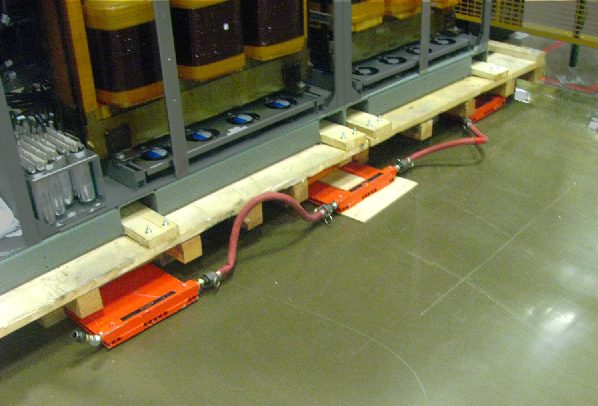 |
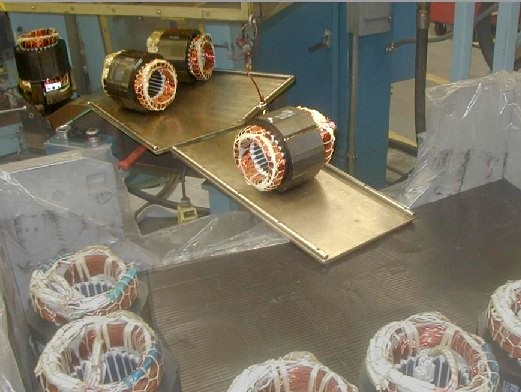 |
| Good, but seldom used options: air casters (left) and slides (right) | |
The basics of material handling are generally well known. However, there are several common problems in setting up material handling systems. A strategy for addressing each of these issues is outlined below.
Address the system as a whole
Efforts to resolve material handling problems often focus too narrowly on one stage of the operation without considering the whole flow of the system.
Generally, it is best to evaluate material handling issues as a whole system, rather than addressing a single stage without consideration for the other stages.
Follow the flow
A good practice is to follow an item all the way through the production process from origin to destination. Actually, it can be helpful to start at the destination, tracing the way back to the item’s origin, since this approach lends itself to optimizing a pull system and the proper deliver of the item at its point of use (see below).
Eliminate transfers and double-handling
Following the flow helps to identify wasted steps such as unnecessary transfers, such as from one material handling piece of equipment to another, or to-and-from storage areas. Generally, fewer transfers mean less wasted time, less risk of damage to the items, and less risk of employee injury from heavy or repetitive lifting.
Combine steps
Sometimes it is possible to combine steps. For example, a delivery cart might be designed so that also serves as a workstation. Thus the need to transfer back and forth between a cart and a workbench is eliminated.
Use compatible equipment
Following the flow also helps to identify mismatches between material handling equipment. Sometimes the mismatch can be as simple as a difference in surface heights, which creates a wasted step of having to lift each item being moved. In other cases, it can lead to an understanding of how the entire system can be simplified, such as by using a conveyor system of some type, or a standardized cart, rather than a multitude of difference pieces of equipment.
Simplify layout
A common benefit of evaluating the material handling system as a whole is highlighting inefficient layouts. All too often, a layout that was once efficient has been disrupted by changes in the operation, such as new machines.
Design for the destination
A design consideration that is often neglected is how best to present the materials to the employee. Generally, the materials should be presented (a) as close as possible to the point of use, both vertically and horizontally, and (b) in the orientation needed for use or for easy access to handle the item.
Materials should ideally be delivered to the point of use in the exact orientation and height that they are to be used. Thus the the design of the material handling system should be set for the needs at the destination.
Of course, the needs at the origin of each step in the material handling system need to be taken into account, and it is not always possible to develop compatible or perfect systems. However, since materials usually need to be handled once at the origin, it is often relatively easy at that point to orient items for the next step in production, and thus eliminate a wasted motion there.
In other words, if an item must be removed by hand from Machine A and placed on a conveyor belt leading to Machine B, then the item should be placed in the orientation needed at Machine B. A
Lean production often refers to the “pull system,” meaning that materials should not be delivered until needed, just-in-time.
Apply lean strategies
There are many aspects and approaches to the lean philosophy, and all of the above steps can be considered part of lean. But the core centers around keeping items flowing as much as possible. Ideally, an item should never stop as it proceeds from its origin to its destination.
Keep materials flowing
There are multiple benefits from achieving this goal, for example:
- In-process inventory drops, saving money in several ways.
- Defects are identified more quickly, enabling faster correction.
Additionally, inherent in lean production are benefits for people. If there is less need to store or stage inventory, then typically there is less need for any type of manual handling. Likewise, concepts like single piece flow can eliminate a considerable amount of wasted, repetitive motions.
Use smaller lot sizes
A standard technique of lean is to reduce lot size. Among many advantages, a benefit of smaller lot size means that containers can be smaller and conveyors narrower, which in turn can mean that it is easier to design so that materials are brought closer to the point of use and thus less reaching, lifting, carrying, and other wasted motions.
Understand the principles
The basic principles of human-friendly design provide a foundation for evaluating equipment design and options. The interface between humans and the material handling system must conform to these principles to the extent feasible. For example:
- Working position: Does the equipment force people to work in awkward positions?
- Force: Is exertion excessive, such as heavy lifting? Can modest changes reduce or eliminate exertion?
- Reach: Are there long reaches that can be improved, such as with narrower conveyors or carts with smaller footprints?
- Height: When people must access material, are the heights of the material appropriate?
- Motions: Does the system create tasks with wasted motions, for example a gap between conveyors and machines that requires all materials to be picked up manually and carried?
- Fatigue: Does the design of the material handling system require people to overload individual muscle groups, such as carrying an item a distance when it would be better to roll?
- Pressure points: Are there hard edges that people come in contact with, such as handles on totes that are too small?
- Clearance: Can items be accessed easily by people? For example, are shelves on a cart too deep and too close together to allow efficient access?
Focus on the manual gaps
Despite elaborate and highly mechanized material handling systems, there are often shortcomings at various points where employees must manually handle the loads.
The following are typical needs for material handling in production operations. At each point, alternative strategies for handling should be brainstormed to find the best strategies.
Within the production line and workstation
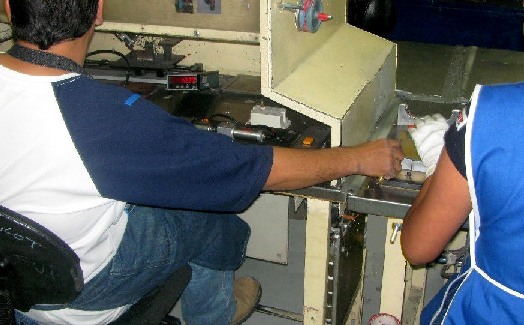 |
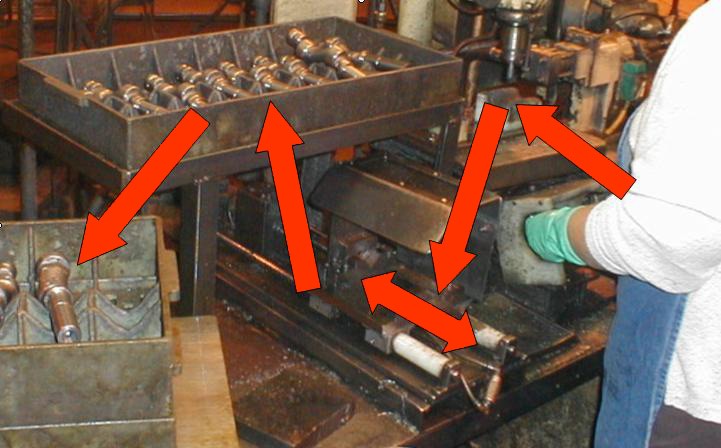 |
| Awkward transfer to next station on production line | Poor flow within workstation |
The production line is generally the starting point for evaluations and planning, for two reasons: (1) it is the focal point of plant operations, usually where the value is added, and (2) the material handling strategies adopted here affect, and sometimes determine, the strategies for the rest of the system. Materials need to be moved from station to station and in and out of fixtures or machines, usually involving manual handling at some point. The system must be designed for efficiency and care of the materials, with minimal wear and tear on employees.
Staging at the production line
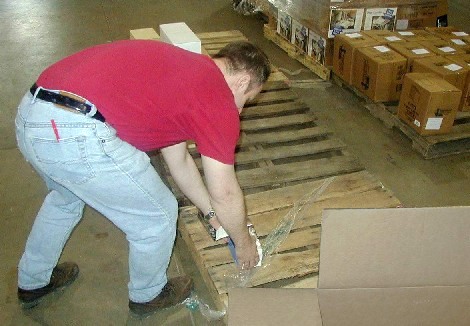 |
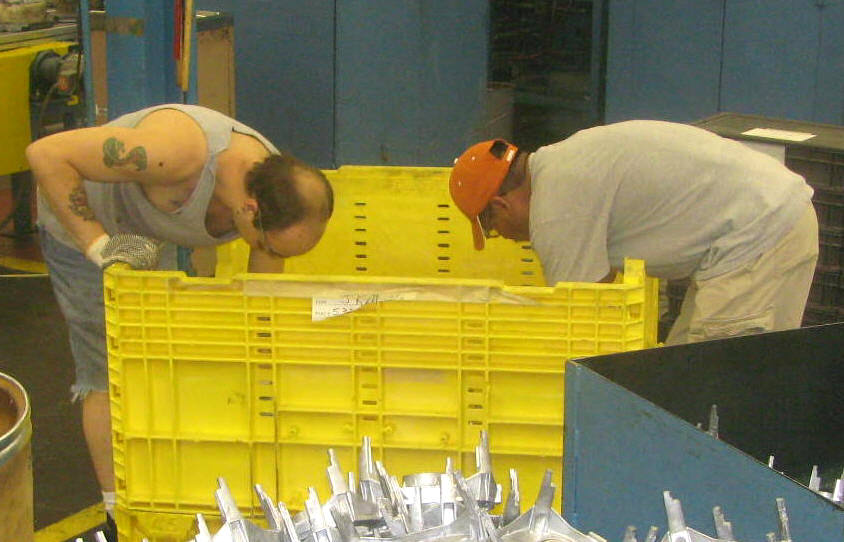 |
| Bending to pallets and into deep containers — slow with high risk of back injury | |
Ideally, materials are delivered to the point of production as they are needed and immediately taken away without any need for staging. However, it is common to have a staging point for incoming components and outgoing products. The classic approach (and typical problem) is placing a pallet or big container on the floor a few feet from where needed. Consequently, employees need to bend, lift, carry, and place the items, which can slow down production and create risk for injury. To the extent possible, materials should be provided to the point of use easily accessed and at the exact height and and orientation that they will be used.
To and from production line
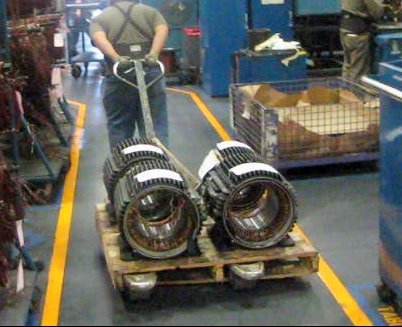 |
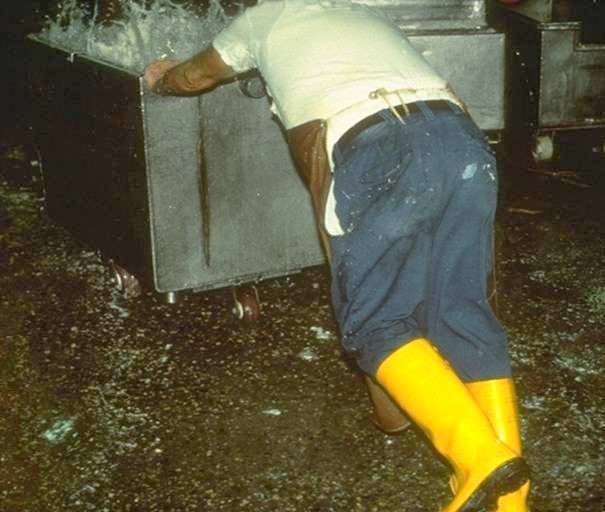 |
| Heavy pull | Heavy push |
Usually this distance is relatively long and is completely mechanical methods are used, such as forklift truck or conveyor. However, the strategy used depends on the design of the production line. That is, the materials need to be delivered ideally exactly when needed and at exactly the right height and orientation in which they are used. Likewise for takeaway. Handling materials within the production line and delivery to and from the production line, although separate functions, must be evaluated and planned as a total system.
In-and-out of warehouse racks
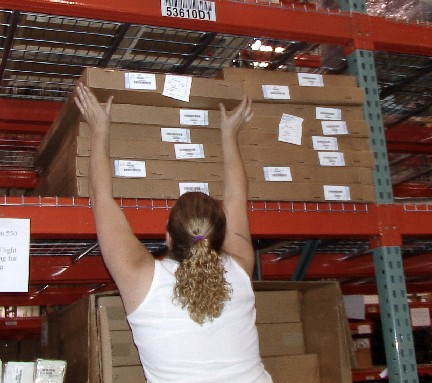 |
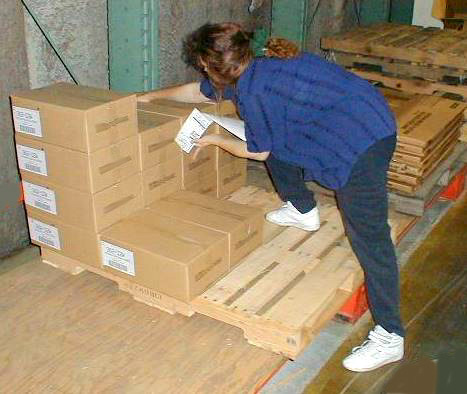 |
| Excessively high pick | Bend and reach |
Ideally, warehousing in a production operation should be eliminated since it represents an extra step. However, as a practical matter, some type of warehousing is needed (but not always!). The typical system involves using forklifts to place materials in racks and does not involve manual handling. However, it is common to remove items by hand, in particular to pick orders for shipment, which is typically very labor intensive and slow with a high risk for back injuries and similar disorders. [Future knowledge base on Order Picking techniques]
On-and-off transport
 |
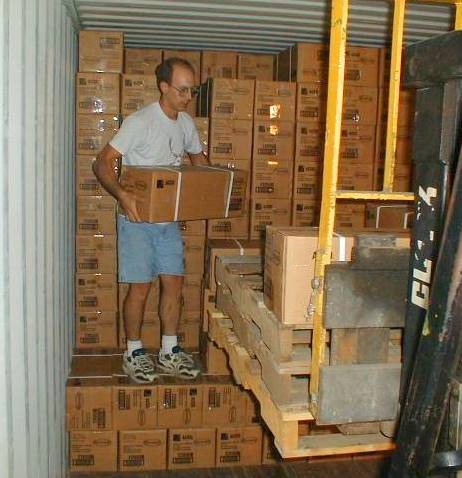 |
| Bed-loaded truck | Shipping container |
Loading and unloading trucks and similar transport such as shipping containers or rail cars is mostly done by forklift truck and not a manual issue. But shipping containers are usually unloaded by hand and bed-loading of trucks and trailers is still common. Both cases are very labor intensive with a high risk of back and shoulder disorders. [Future knowledge base on loading/unloading trucks and shipping containers.]
Identify equipment options
Workplace personnel are frequently not familiar with the full array of options that can be used in various situations.
In the context of this web site there are several major equipment strategies for moving materials, including vertical movement. All of these strategies can be employed at the various points of need as outlined below. The material handling knowledgebase provides a comprehensive list of techniques for consideration. The following provides an overview:
Conveyors and slides — There are many types of conveyors are widely used, plus some styles that are routinely used in some industries, but hardly known in others, such as screw conveyors, vertical conveyors, and air conveyors. Slides can be effective and low-cost, but seldom are considered as a design strategy. Both conveyors and slides could be much more widely used with more consideration of easy-to-open gates.
Carts — A cart is an age-old strategy for handling, now available in countless innovative configurations. The selection of wheel for the cart can be critical, plus can be added to many types of equipment for easier movement. Air casters have come into their own as an alternative to the wheel.
Lift trucks — There are multiple styles of lift trucks that are available, including the less well known styles of “walkie” trucks. In recent years a new class of powered tuggers has evolved that are small, yet powerful. A new cross-breed of lifter-transporters combines the functions of a cart with those of a power lift.
Hoists — Various types of hoists are traditional for material handling, but new adaptations like vacuum hoists have shown special value. Manipulator arms may be considered in this category.
Power lifts — Multiple styles of pallet and container lifts are available and advancement continues.Dumpers and tilters can be included here.
Containers and pallets — The choice of pallet, container, or totes can affect the strategy for movement. Specific aspects of the design of each can affect production and employee well-being. Material handling must be evaluated as a full system from transport into the facility to movement down a production line.
See Material Handling Taxonomy by North Carolina State University for an excellent, systematic overview of categories and types of material handling equipment.
– – –
In essence, you should review each of your needs for handling in light of the equipment strategies listed above and the knowledge base of specific techniques for each.
Material handling issues must also be integrated with the design of workstations and incorporated into the improvement of the machine-operator interface.
Risk of long term injuries
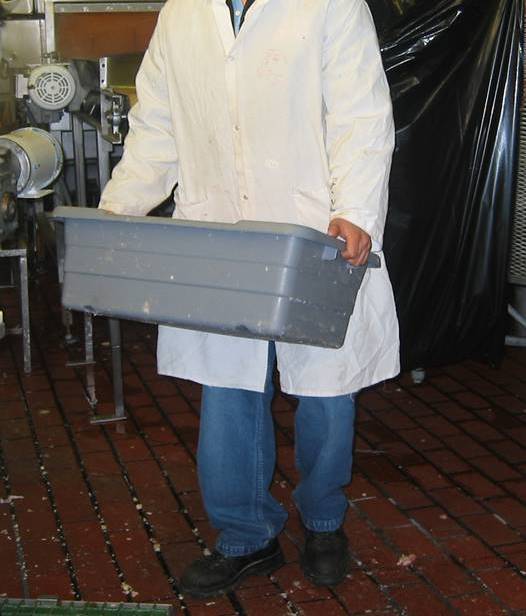 |
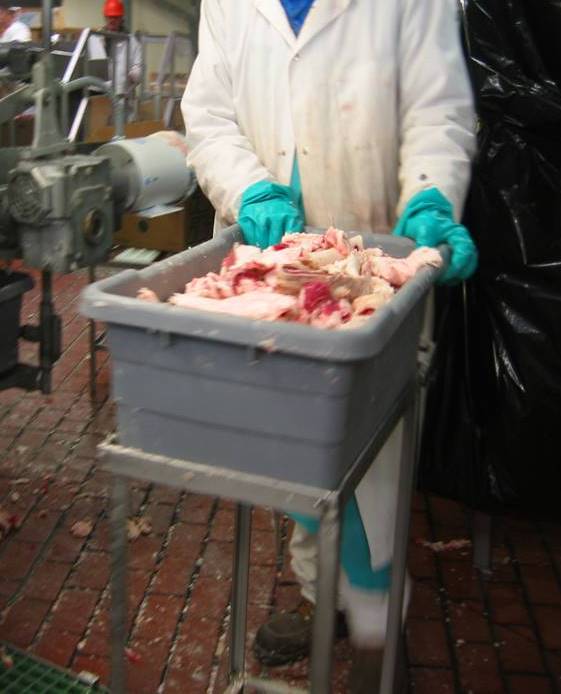 |
| Manual carry — Can waste time and create strain on body | Inexpensive cart — An age-old strategy for moving items easily |
Manual material handling tasks are often the jobs with the highest risks for Musculoskeletal Disorders (MSDs), i.e., back injuries from bending, lifting, carrying, and positioning materials. It is also common for productivity to be reduced by the same factors, that is, the extra time that it takes to bend, lift, carry, and position materials.
Picking up and carrying items can waste time and create strain on the hands, arms, and back. The concern is usually greater when the items are heavy or the distances that they are carried are long, but even handling small items short distances can create problems.
